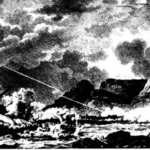Wolraad Woltemade and the wreck of Die Jonge Thomas
The Jonge Thomas was a Dutch East India ship, that was built in 1764 at the VOC yard at Amsterdam in 1764 for the Chamber of the VOC at Amsterdam. It weighed 1.150 tons and was about 150 feet long. She was a ‘retour vessel’, meaning that she was used in the service between the Dutch East Indies and the Netherlands.
Shortly after 5 am on the morning of 1 June 1733 a storm which had been raging all night, caused the Jonge Thomas that was anchored at the mouth of the Salt River in Table Bay to break loose. It hit the jagged rocks of Salt River, breaking it in half. Jonge Thomas’ Captain, Barend Lameren, ordered the ship’s cannon fired to warn the people on shore that they may need help.
Many lost their lives but others clung to the upturned hull, some sailors attempted to swim ashore, however, the water was cold and a strong current carried them back out to sea. Among some eyewitnesses was Wolraad Woltemade who had been on an errand, travelling on horseback. On seeing what was happening Wolraad rode his horse out to sea on a rescue mission. Wolraad made 7 trips out to the boat and saved 14 men. Sadly on his last attempt, too many men grabbed at the horse Wolraad and the exhausted animal drowned. Wolraad’s body was washed ashore but his horse called Vonk was never found.
Originally, Woltemade’s actions were not widely recognized. The first report from the Dutch East India Company did not mention his name but focused on the gold recovered from the wreck. However, Swedish naturalist Carl Peter Thunberg, who witnessed the event, documented Woltemade’s bravery, ensuring his story was preserved.


